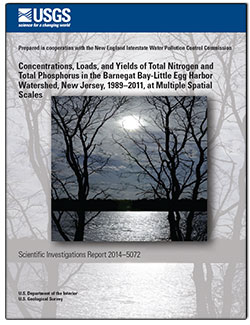 Abstract
Abstract
Concentrations, loads, and yields of nutrients (total nitrogen and total phosphorus) were calculated for the Barnegat Bay-Little Egg Harbor (BB-LEH) watershed for 1989–2011 at annual and seasonal (growing and nongrowing) time scales. Concentrations, loads, and yields were calculated at three spatial scales: for each of the 81 subbasins specified by 14-digit hydrologic unit codes (HUC-14s); for each of the three BB-LEH watershed segments, which coincide with segmentation of the BB-LEH estuary; and for the entire BB-LEH watershed. Base-flow and runoff values were calculated separately and were combined to provide total values.
Available surface-water-quality data for all streams in the BB-LEH watershed for 1980–2011 were compiled from existing datasets and quality assured. Precipitation and streamflow data were used to distinguish between water-quality samples that were collected during base-flow conditions and those that were collected during runoff conditions. Base-flow separation of hydrographs of six streams in the BB-LEH watershed indicated that base flow accounts for about 72 to 94 percent of total flow in streams in the watershed.
Base-flow mean concentrations (BMCs) of total nitrogen (TN) and total phosphorus (TP) for each HUC-14 subbasin were calculated from relations between land use and measured base-flow concentrations. These relations were developed from multiple linear regression models determined from water-quality data collected at sampling stations in the BB-LEH watershed under base-flow conditions and land-use percentages in the contributing drainage basins. The total watershed base-flow volume was estimated for each year and season from continuous streamflow records for 1989–2011 and relations between precipitation and streamflow during base-flow conditions. For each year and season, the base-flow load and yield were then calculated for each HUC-14 subbasin from the BMCs, total base-flow volume, and drainage area.
The watershed-loading application PLOAD was used to calculate runoff concentrations, loads, and yields of TN and TP at the HUC-14 scale. Flow-weighted event-mean concentrations (EMCs) for runoff were developed for each major land-use type in the watershed using storm sampling data from four streams in the BB-LEH watershed and three streams outside the watershed. The EMCs were developed separately for the growing and nongrowing seasons, and were typically greater during the growing season. The EMCs, along with annual and seasonal precipitation amounts and percent imperviousness associated with land-use types, were used as inputs to PLOAD to calculate annual and seasonal runoff concentrations, loads, and yields at the HUC-14 scale.
Over the period of study (1989–2011), total surface-water loads (base flow plus runoff) for the entire BB-LEH watershed for TN ranged from about 455,000 kilograms (kg) as N (1995) to 857,000 kg as N (2010). For TP, total loads for the watershed ranged from about 17,000 (1995) to 32,000 kg as P (2010). On average, the north segment accounted for about 66 percent of the annual TN load and 63 percent of the annual TP load, and the central and south segments each accounted for less than 20 percent of the nutrient loads. Loads and yields were strongly associated with precipitation patterns, ensuing hydrologic conditions, and land use. HUC-14 subbasins with the highest yields of nutrients are concentrated in the northern part of the watershed, and have the highest percentages of urban or agricultural land use. Subbasins with the lowest TN and TP yields are dominated by forest cover.
Percentages of turf (lawn) cover and nonturf cover were estimated for the watershed. Of the developed land in the watershed, nearly one quarter (24.9 percent) was mapped as turf cover. Because there is a strong relation between percent turf and percent developed land, percent turf in the watershed typically increases with percent development, and the amount of development can be considered a reasonable predictor of the amount of turf cover in the watershed. In the BB-LEH watershed, calculated concentrations of TN and TP were greater for developed–turf areas than for developed–nonturf areas, which, in turn, were greater than those for undeveloped areas.